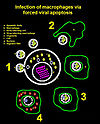
Viral shedding
Encyclopedia
Viral shedding refers to the successful reproduction, expulsion, and host-cell infection caused by virus
progeny. Once replication has been completed and the host cell
is exhausted of all resources in making viral progeny, the viruses may begin to leave the cell by several methods.
The term is used to refer to shedding from a single cell, shedding from one part of the body into another part of the body, and shedding from bodies into the environment where the viruses may infect other bodies.
 "Budding" through the cell envelope, in effect using the cell's membrane
"Budding" through the cell envelope, in effect using the cell's membrane
for the virus itself is most effective for viruses that need an envelope in the first place. These include enveloped viruses such as HSV
, SARS or smallpox
. Prior to budding, the virus may put its own receptor onto the surface of the cell in preparation for the virus to bud through, forming an envelope with the viral receptors already on it. This process will slowly use up the cell membrane and eventually lead to the demise of the cell. This is also how antiviral responses are able to detect virus infected cells.
 By forcing the cell to undergo apoptosis
By forcing the cell to undergo apoptosis
or cell suicide, release of progeny into the extracellular
space is possible. However, apoptosis does not necessarily result in the cell simply popping open and spilling its contents into the extracellular space. Rather, apoptosis is usually controlled and results in the cell's genome
being chopped up, before apoptotic bodies
of dead cell material clump off the cell to be absorbed by macrophages. This is a good way for a virus to get into macrophages either to infect them or simply travel to other tissues in the body. Although this process is primarily used by non-enveloped viruses, enveloped viruses may also use this. HIV
is an example of an enveloped virus that exhibits this process for the infection of macrophages.
 In exocytosis the host cell is not destroyed. Viral progeny are synthesized within the cell and the host cell's transport system is used to enclose vacuoles of virus progeny for release into the extracellular space. This is used primarily by non-enveloped viruses, although enveloped viruses display this too. An example is the use of recycling viral particle receptors in the enveloped varicella-zoster virus.
In exocytosis the host cell is not destroyed. Viral progeny are synthesized within the cell and the host cell's transport system is used to enclose vacuoles of virus progeny for release into the extracellular space. This is used primarily by non-enveloped viruses, although enveloped viruses display this too. An example is the use of recycling viral particle receptors in the enveloped varicella-zoster virus.
Virus
A virus is a small infectious agent that can replicate only inside the living cells of organisms. Viruses infect all types of organisms, from animals and plants to bacteria and archaea...
progeny. Once replication has been completed and the host cell
Cell (biology)
The cell is the basic structural and functional unit of all known living organisms. It is the smallest unit of life that is classified as a living thing, and is often called the building block of life. The Alberts text discusses how the "cellular building blocks" move to shape developing embryos....
is exhausted of all resources in making viral progeny, the viruses may begin to leave the cell by several methods.
The term is used to refer to shedding from a single cell, shedding from one part of the body into another part of the body, and shedding from bodies into the environment where the viruses may infect other bodies.
Via budding

Cell membrane
The cell membrane or plasma membrane is a biological membrane that separates the interior of all cells from the outside environment. The cell membrane is selectively permeable to ions and organic molecules and controls the movement of substances in and out of cells. It basically protects the cell...
for the virus itself is most effective for viruses that need an envelope in the first place. These include enveloped viruses such as HSV
Herpes simplex virus
Herpes simplex virus 1 and 2 , also known as Human herpes virus 1 and 2 , are two members of the herpes virus family, Herpesviridae, that infect humans. Both HSV-1 and HSV-2 are ubiquitous and contagious...
, SARS or smallpox
Smallpox
Smallpox was an infectious disease unique to humans, caused by either of two virus variants, Variola major and Variola minor. The disease is also known by the Latin names Variola or Variola vera, which is a derivative of the Latin varius, meaning "spotted", or varus, meaning "pimple"...
. Prior to budding, the virus may put its own receptor onto the surface of the cell in preparation for the virus to bud through, forming an envelope with the viral receptors already on it. This process will slowly use up the cell membrane and eventually lead to the demise of the cell. This is also how antiviral responses are able to detect virus infected cells.
Via apoptosis

Apoptosis
Apoptosis is the process of programmed cell death that may occur in multicellular organisms. Biochemical events lead to characteristic cell changes and death. These changes include blebbing, cell shrinkage, nuclear fragmentation, chromatin condensation, and chromosomal DNA fragmentation...
or cell suicide, release of progeny into the extracellular
Extracellular
In cell biology, molecular biology and related fields, the word extracellular means "outside the cell". This space is usually taken to be outside the plasma membranes, and occupied by fluid...
space is possible. However, apoptosis does not necessarily result in the cell simply popping open and spilling its contents into the extracellular space. Rather, apoptosis is usually controlled and results in the cell's genome
Genome
In modern molecular biology and genetics, the genome is the entirety of an organism's hereditary information. It is encoded either in DNA or, for many types of virus, in RNA. The genome includes both the genes and the non-coding sequences of the DNA/RNA....
being chopped up, before apoptotic bodies
Bleb (cell biology)
In cell biology, a bleb is an irregular bulge in the plasma membrane of a cell caused by localized decoupling of the cytoskeleton from the plasma membrane...
of dead cell material clump off the cell to be absorbed by macrophages. This is a good way for a virus to get into macrophages either to infect them or simply travel to other tissues in the body. Although this process is primarily used by non-enveloped viruses, enveloped viruses may also use this. HIV
HIV
Human immunodeficiency virus is a lentivirus that causes acquired immunodeficiency syndrome , a condition in humans in which progressive failure of the immune system allows life-threatening opportunistic infections and cancers to thrive...
is an example of an enveloped virus that exhibits this process for the infection of macrophages.
Via exocytosis


